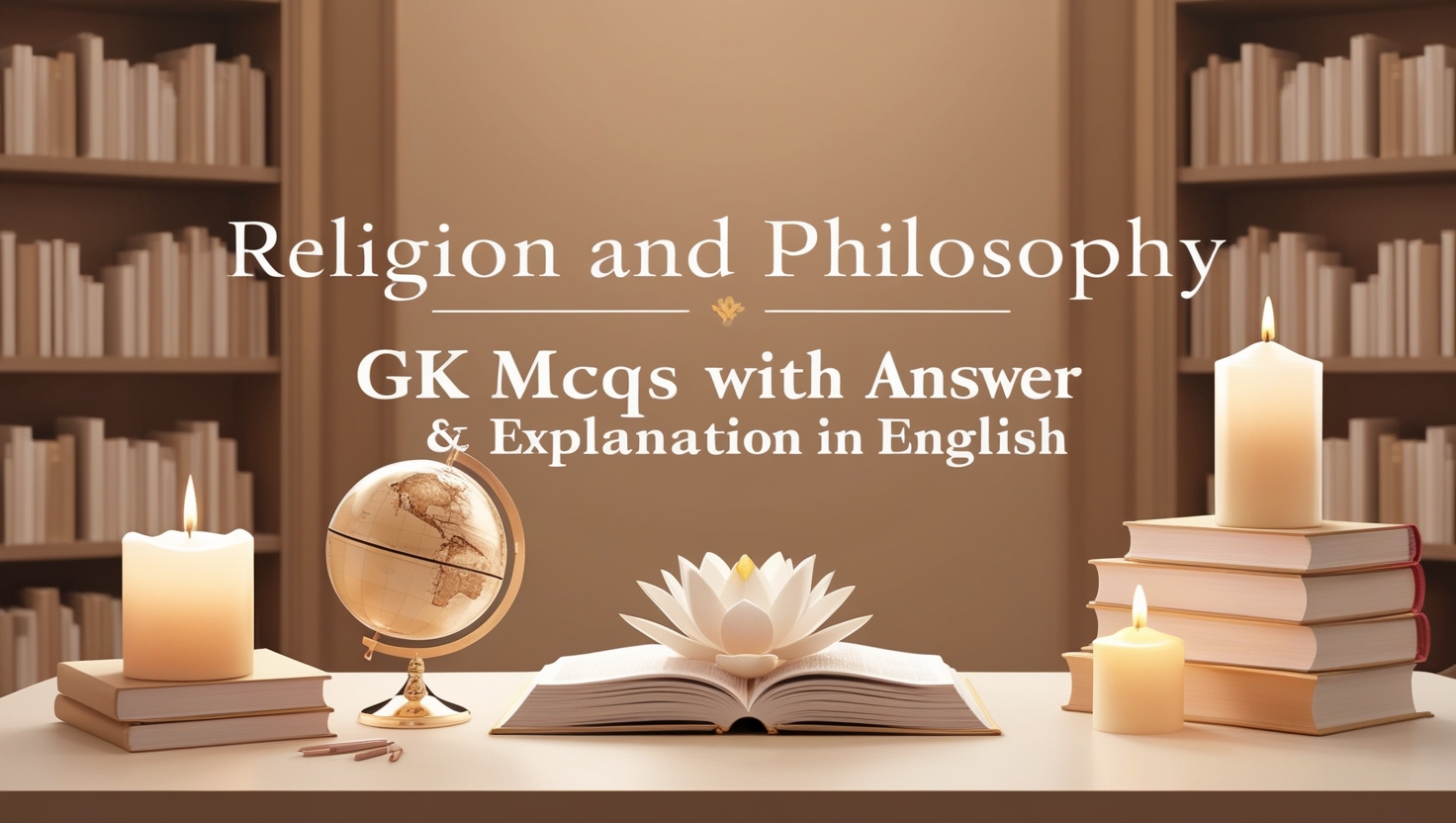
Religion and Philosophy GK MCQs With Answer & Explanation in English offers a comprehensive collection of multiple-choice questions designed to deepen your understanding of religious traditions and philosophical concepts. This article is a valuable resource for students, educators, and aspirants preparing for competitive exams, providing well-explained answers for better clarity.
Explore the fascinating world of belief systems and ideas that have shaped human thought and culture.
1. Lal Ded (Lalla Yogeshwari) was a practitioner of which of the following traditions?
- Tibetan Buddhism
- Kashmir Shaivism
- Sri Sampradaya
- Smartism
Show Answer
Answer: Kashmir Shaivism
Lal Ded, also known as Lalla Yogeshwari, was a 14th-century Kashmiri saint and poetess. She is widely regarded as one of the most important figures in the Bhakti movement of Kashmir. Lal Ded was an ardent practitioner of Kashmir Shaivism, a philosophical and spiritual tradition that emphasizes the direct experience of the divine through self-realization. This tradition, also known as Trika Shastra, was founded by Vasu Gupta and forms a significant part of Kashmiri Shaiva philosophy.
2. World’s largest religion (population wise) is:
- Hindu
- Muslim
- Christian
- Buddhists
Show Answer
Answer: Christian
Christianity is one of the world’s major religions, with followers worldwide. As of my last knowledge update in September 2021, it is estimated to have over 2.3 billion adherents, which makes it the largest religion in the world. This accounts for approximately one-third of the global population.
3. Famous sufi saint Nizamuddin Auliya settled in Delhi during whose time of the following?
- Akbar
- Jahangir
- Shahjahan
- Aurangjeb
Show Answer
Answer: Akbar
Nizamuddin Auliya, a 13th-century Sufi saint and spiritual leader, settled in Delhi, India, during the reign of the Mughal emperor Akbar. He is known for his teachings and his association with the Chishti Sufi order. The shrine of Nizamuddin Auliya, known as the Nizamuddin Dargah, remains a significant center of Sufi devotion and is located in Delhi.
4. Santhara is a religious ritual related to:
- Jain
- Saiva
- Sakta
- Vaishnava
Show Answer
Answer: Jain
Santhara, also known as Sallekhana, is a Jain religious practice of voluntary fasting unto death. It is undertaken by devout Jains, primarily in the later stages of life, as a means to purify the soul and achieve a peaceful and conscious departure from the world. It involves gradually reducing food and water intake until the person peacefully passes away. This practice is seen as a way to detach from worldly attachments and attain spiritual liberation.
5. In context with the Mahayana Buddhism faith, the future Buddha is?
- Krakuchanda
- Amitabha
- Maitreya
- Kanak Muni
Show Answer
Answer: Maitreya
In Mahayana Buddhism, Maitreya is believed to be the future Buddha. Maitreya, also known as the “Buddha of the Future” or “Bodhisattva Maitreya,” is considered to be the next enlightened being who will appear in the world to teach the Dharma and guide sentient beings toward enlightenment. The concept of Maitreya is an essential element of Mahayana Buddhist beliefs and provides hope for a future age of spiritual awakening.
6. One of the incarnations of Vishnu is represented in art as raising the Earth from the Ocean. Identify Him from the given options:
- Kumara
- Varaha
- Matsya
- Nrisingha
Show Answer
Answer: Varaha
In Hinduism, Lord Vishnu is believed to have incarnated in various forms to protect and preserve the universe. One of his significant incarnations is as Varaha, the boar avatar. According to Hindu mythology, Varaha rescued the Earth by raising it from the cosmic ocean, which had threatened to engulf it. This event symbolizes the divine’s protective and nurturing role in Hindu cosmology.
7. According to the beliefs of the Pasupata sect, Siva is the lord of Pasu. Pasu here refers to?
- Lion
- Bull
- Parvati
- Jiva
Show Answer
Answer: Jiva
According to the Pasupata sect: The Pasupata sect is a Shaiva tradition within Hinduism. According to their beliefs, Shiva is considered the supreme deity and the Lord of Pasu, which refers to the individual soul (Jiva). This sect emphasizes devotion to Lord Shiva and the pursuit of spiritual liberation.
8. God knows man’s virtues and inquires not his caste; in the next world there is no caste.” This teaching is of_?
- Kabir
- Guru Nanak
- Chaitanya
- Ramananda
Show Answer
Answer: Guru Nanak
This teaching is of Guru Nanak.
9. A devotional saint and a cobbler by profession was ?
- Tulsidas
- Surdas
- Raidas
- Malukdas
Show Answer
Answer: Raidas
Raidas, also known as Ravidas or Guru Ravidas, was a prominent devotional saint in the Bhakti movement in North India. He was a cobbler by profession and is revered for his devotional hymns and poetry that emphasized social equality and the oneness of God. His teachings and verses have had a significant impact on the Bhakti and Sant traditions in India.
10. The Varkari sect in Maharashtra was founded by?
- Tukaram
- Namdev
- Visoba Khechar
- Dhyaneshwar
Show Answer
Answer: Dhyaneshwar
The Varkari sect in Maharashtra was founded by Dhyaneshwar.







